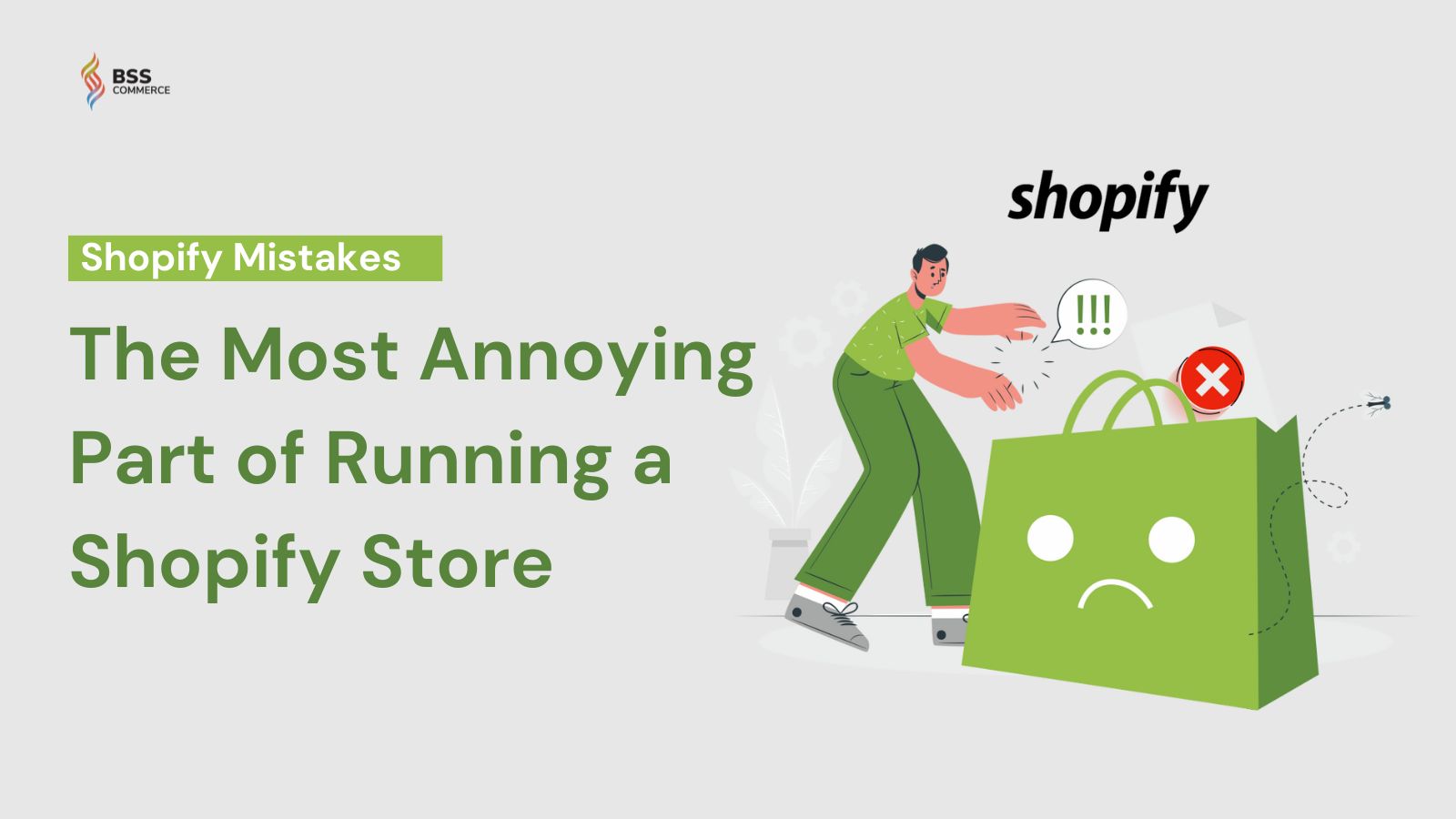Shopify, though a leading eCommerce platform, has some frustrating limitations in place that overcomplicate the life of a store owner – especially if they are small business owners. Before you hit that big “Publish” button, it’s nice to have a look at some of the annoying sides of using Shopify. In this article, we will talk about the 12 most annoying Shopify mistakes and issues you need to know to make your journey smoother and extra profitable.
Contents
- 1 The 12 Most Annoying Shopify Mistakes and Issues No One Warned You About
- 1.1 1. Having to install too many apps for basic functionality
- 1.2 2. Shopify’s limited tax settings
- 1.3 3. Dealing with challenging customer interactions
- 1.4 4. Struggling with unreliable third-party vendors (spammers)
- 1.5 5. Converting traffics into buyers is challenging
- 1.6 6. High transaction fees for non-Shopify Payments
- 1.7 7. Lack of built-in multilingual support
- 1.8 8. Difficulties in scaling with Shopify’s pricing plans
- 1.9 9. Limited control over SEO features
- 1.10 10. Limited control over checkout customization
- 1.11 11. Ignoring broken links and slow loading pages
- 1.12 12. Using .myshopify.com domain instead of a custom domain
- 2 Key Takeaways
The 12 Most Annoying Shopify Mistakes and Issues No One Warned You About
Is running a Shopify store easy? Well, that depends. While Shopify can be one of the most potent online business tools, there are a couple of pros and cons to consider. This section talks about the most annoying part of running a Shopify store, as verified by experienced users, and some Shopify mistakes to avoid.
1. Having to install too many apps for basic functionality
Shopify’s basic setup feels super bare-bones, and even simple features require apps on their own. Want to bundle products? There’s an app for that. Want to collect customer reviews? Well, there’s another for that. Need to generate invoices or set “per item” shipping costs? Well, there is yet another app for this.
This endless juggling act of 20+ apps (often paid) can be overwhelming, and it is seriously exhausting trying to remember which app does what. Moreover, it really adds complexity and more expenses on a monthly basis.
To save yourself this headache, have a rough idea of what functions you need versus what you want before you begin to invest in Shopify. Look for bundled applications that could accomplish several functions, or, if possible, upgrade to the Shopify Plus plan. Alternatively, you can use tools like Taranker’s Shopify App Ranking and Review Guide to help you find the best apps for Shopify. With Taranker, you can easily compare, rank, and review different apps, saving you time and money while simplifying your setup process.

2. Shopify’s limited tax settings
Another hardest part of running a Shopify store, especially for small business owners, is dealing with Shopify’s limited tax features. For example, it lacks in-built features regarding VAT validation. As a result, businesses operating in such regions have no choice but to either do a manual validation of VATs or seek third-party apps, which are normally expensive.
Moreover, the Shopify tax settings support unique tax exemptions and varied regional rules, either to a very limited extent or not at all. That means that the complexity of tax compliance rests with the store owner.
For safety’s sake, it would be proper to look at the needs of your business as relates to taxes and consider the additional cost that may arise from apps to be used upon working with regions where VAT is high.

3. Dealing with challenging customer interactions
Handling customer complaints can be the worst thing of running a Shopify store. As much as one is prepared, they cannot believe just how unpredictable some situations can be. There will certainly be issues that are out of your hands, like the regional differences in prices, unmet shipping expectations, or customers ignoring the sizing guide.
Focus on easy-to-understand FAQs, guides, and support resources. Infographics that show sizing or shipping policies can answer FAQs and grease the skids for otherwise painful interactions.
Be prepared with a strong mentality, too. If there are things that can’t be helped, a refund won’t hurt your business.
4. Struggling with unreliable third-party vendors (spammers)
The minute you create a Shopify store, get ready for tons of unsolicited messages from spammers and third-party vendors who seem to magically attain your contact information. You can expect daily emails and DMs by the dozen from services you never asked for. It’s just another annoying part of running a Shopify store.
While this is not a Shopify mistake per se, you can avoid much of this by setting up an email, especially for the inquiries that your store gets from vendors, and trying to keep your contact information from being publicly available. These may not totally eliminate spam, but at least they let you keep the volume in check and your main inbox a little cleaner.

5. Converting traffics into buyers is challenging
Every eCommerce, as well as Shopify, faces complexity in converting captured traffic into buyers. People visit but hardly turn into customers due to various issues related to trust, not getting clear information about the product, or friction in checkout.
Into that, depending on the target segment, one should also run highly targeted advertisements, create strategic campaigns, and optimize the landing pages in your store for conversions. Try perfecting your product descriptions to improve image quality, or even using social proof like reviews to help build credibility.
Other than that, make use of any analytics tool. This will analyze the behavior of your visitors so you can identify these drop-off points and then fix them.
6. High transaction fees for non-Shopify Payments
Shopify has its own Shopify Payments system and will charge extra fees for alternative payment gateways such as PayPal, Stripe, or Authorize.net. While this is nothing out of the ordinary for some platforms, Shopify’s rates do run a bit high, ranging between 0.5% and 2%, depending on which plan you are operating on.
This is not necessary one of the annoying Shopify mistakes, but if you do not want to use Shopify Payments, get ready to add on more costs to each of your sales.
7. Lack of built-in multilingual support
Shopify has its limitations in terms of multilingual support. Although the platform does support up to 20 languages with built-in tooling, this is only offered on the Advanced plan.
With the smaller plans, only basic multilingual support is provided, and the absence of some other features, such as automatic translation and separate URLs according to the language, can make localization more cumbersome. If global expansion is a priority, one may budget for a translation app or opt for a higher Shopify plan.
8. Difficulties in scaling with Shopify’s pricing plans
Shopify’s pricing plans have the intrinsic design of upselling, but their pricing jumps significantly from plan to plan. This puts the small to midsized business in a predicament where they have to pay way more than necessary for all the features needed or be left without functionality due to choosing lower-tier options.
So, be sure to watch your needs before upgrading. Quite often, third-party apps will offer advanced functionality for far less and let you defer full upgrades until absolutely necessary. Only invest in higher tiers when the features are directly tied to growth or have a measurable ROI.

9. Limited control over SEO features
SEO is extremely important for organic traffic, and Shopify allows very limited control over its settings. With Shopify, most of the essentials are there: meta tags, alt text, and basic on-page SEO features, but store owners may have limitations with advanced strategies that involve customizing URL structures or dealing effectively with 301 redirects.
Solution to this? You can install third-party SEO plugins or apps that extend beyond what Shopify offers. Plug-in SEO and SEO Manager provide more advanced features. However, they do come at a price.
Another option would be the integration of Google Search Console and Analytics with Shopify. This helps in the tracking and adjusting of keyword performance, site speed, and traffic analysis.
10. Limited control over checkout customization
This probably would be annoying to a small business because Shopify does not fully control the ability for checkout customization. The platform limits serious checkout options to the highest-tier Shopify Plus plan, which, for most of the smaller stores, is extremely expensive.
Without these options, businesses cannot adapt the checkout fully to fit their branding, to ease the process, or even add a feature like more fields for customer information. This inability to personalize the last step in the sales funnel can be viewed as constricting and is a source of frustration for any business looking to provide a tailored shopping experience.

11. Ignoring broken links and slow loading pages
High bounce rates are typically founded on Shopify mistakes like not minding broken links and slow loading pages. Since customers these days expect to have a smooth, quick browsing experience, the onsets of such problems may infuriate them, or they may lose their trust and leave without buying anything.
The smoother, faster, and easier the browsing experience, the better the engagement of customers will be, at a higher degree of likelihood for conversion. Regularly audit your Shopify store for broken links and optimize images and scripts for improving load times. You can always use tools like Google PageSpeed Insights to help you out.
12. Using .myshopify.com domain instead of a custom domain
This is among the most common mistakes to avoid on Shopify, yet so many new store owners overlook it. Selling on a default “yourstorename.myshopify.com” domain is amateurish. Visitors may perceive that your store is temporary or less established, which again affects conversion rates.
Building a professional brand befits the investment in a custom domain that reflects your store’s identity. A custom domain isn’t a huge expense, but rather it may help to make your store more credible and add authenticity, and this is good in terms of SEO since search engines can find your website with more ease.

Key Takeaways
- Shopify’s basic setup is very limited, and it requires add-ons for essential functions like tax configurations, SEO, and checkout options.
- Turning website traffic into sales involves a lot of site optimization.
- Managing unpredictable customer complaints and issues can be exhausting.
- Mobile optimizations end up needing many more changes than initially anticipated.
- Be prepared for spam from vendors.
On the other hand, do not overcomplicate the checkout, neglect SEO setup, distract with the color scheme, misunderstand buyer intent, or rely only on paid ads. Not only do these Shopify mistakes make attracting and retaining customers more cumbersome, but they also bring down the credibility of your store and narrow the perspective of growth.
That concludes our article on Shopify mistakes and the annoying sides of using Shopify. Generally speaking, Shopify is a very powerful platform with enormous potential, but there’s also its particular set of challenges. You will, therefore, be able to avoid many of the common Shopify mistakes and manage some of the most frustrating aspects effectively.
Enjoyed our content so far? Visit BSS Commerce for more Shopify tips and tricks.




